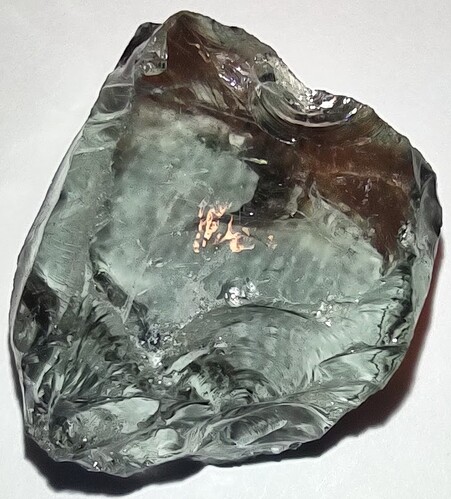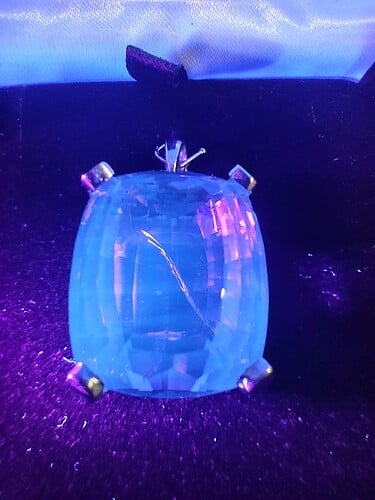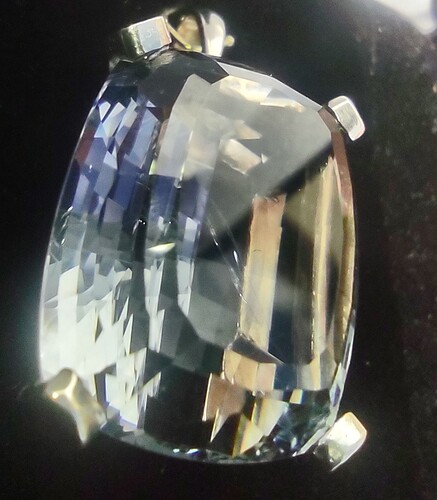Hello all. I’ve spent the last few years trying to have some rough identified and recently had some faceted. Have had a lot of varied opinions and nothing fits exactly with these. It is trichroic. SG-2.77 and RI-1.54. MOHS 6-7.
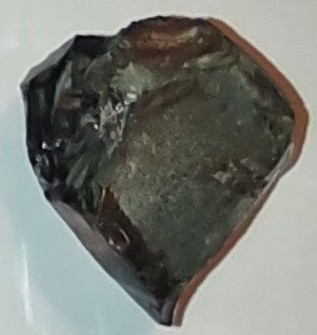
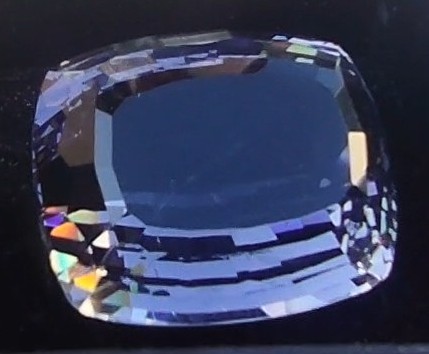
Thank you. Any help is appreciated.
Your stone appears to be the gem form of cordierite and known generally as iolite. It is unusual because it is trichroic and is always cut to display a blue-violet color. However, iolite is generally not as well known as other purplish gems such as amethyst and tanzanite.
1 Like
I had heard that cordierite (iolite) is likely and am satisfied with that answer. The specific gravity being a bit off, and closer to several others had me unsure. Thanks for the help!
1 Like
Another helpful characteristic would be the specific colors of the trichroism. Iolite would be 1) pale yellow to green, 2) violet to blue-violet and 3) pale blue. -royjohn
1 Like
Thank you, I really appreciate the help from this forum. I think you’re both right. It’s pale green, blue/violet and gray/colorless depending on the lighting. Is it true that a clean gem over 10ct is rare?
No, it isn’t particularly rare. I usually use GemRockAuctions when I am looking for stones that are out of the ordinary and not listed in my Gemworld Guide. I see some ~20 ct iolites for sale at about $100/ct, but they look darker than your stone, but perhaps that is the photography. I would say that the preferred color for iolite would be a premium sapphire color. Much of the iolite that I have seen is too dark when cut on the darkest axis. Lighter than “best sapphire” colors would be valued at less than those. -royjohn
1 Like
Thanks for the info, this is a great forum for beginners like myself.
My only sticking point with the iolite consideration would be how high the dispersion seems to be. Also, S, C, Si, Na, Al, Ca, P, Mn, Pb, Cu, K, O, Cl, Ti, W and Ba are elements seen by SEM.
By XRF- Strontium(82.91%), Zr (13.95%), Sb(1.8%), Zn(1.04%), and Ce(0.24%).
I don’t think what you are seeing is dispersion. Iolite at 0.017 has only moderate dispersion. What you are probably seeing is flashes of color from the different trichoic axes…odd rays are coming out of the stone obliquely with different colors from the predominant blue-violet. I don’t understand the comment about the various ions. Was this stone tested by SEM and XRF? -royjohn
Yes, I’ve had several XRF studies and SEM. The XRF scans have given differing results. I’m wondering if this picture under LW highlighting the veil with the elements listed previously as seen by SEM and XRF can help determine if iolite is still likely?
There aren’t a lot of stones that are transparent and trichroic, so it’s now down to whether your observations and measurements are correct. Your SG is a little high for the published range of values for iolite, but that could be due to errors in measurement depending on how you did the SG and how good your technique was. Trichroism is easy to see in rough, but perhaps in the cut stone you should use a dichroscope and be sure you are operating it correctly. By changing the orientation of the stone relative to the dichroscope, you should be able to see all three colors. If your stone is trichroic, your RI is correct, your hardness correct and your SG is near correct, what else could this stone be? I don’t know how to interpret your XRF or SEM data. Maybe someone at GIA or one of the other labs can help with that. -royjohn
The RI of 1.54 was done by a jeweler friend of the lapidary and he and I got almost identical SG’s. I do have a dichroscope and spectroscope but haven’t quite reached novice level at using most of the testing equipment I own. I’m confident with doing specific gravity but that’s about it. When I scratched the rough, I calculated it at 8+, but the lapidary says it’s softer.
I recently read about Riesling beryl and johnkoivulite and wondered what might prove or disprove these as possibilities. One site about Riesling beryl notes that beryl is commonly mistaken for glass. I’m nearly certain this isn’t glass, by the twinning plane, ‘veil’ as the lapidary called it, or inclusions running through it and am wondering if this could be a new source, and possibly, new type of beryl with slightly different properties to most beryl types?
Thanks again for all the help, it looks like taking it to a university is a good idea. Any suggestions on the west coast that you might suggest?
1 Like
Hi Scott,
I think Iolite is the right fit based on your optical and physical properties. In particular the fact the you have a trichroic/dichroic mineral matches the Iolite. Being trichroic - you will have THREE refractive indices. A polariscope may help confirm - Iolite is biaxial although it can be positive or negative.
But the geochemical information is totally anomalous with that. SEM uses EDS detectors (energy dispersive spectrum). These measure X-rays using silicon detectors and provide semi-quantitiative results if used with standards and calibration, which they usually are not. So they give a quick and dirty idea of what might be in the sample. XRF also measures X-Rays but will do so using a crystal detector and this measures X-Ray wavelength. XRF is more sensitive and accurate. SEM-EDS can also give a map by element - so you would be able to discriminate spatially whether you are dealing the the veil in the gem or the gem itself.
Both XRF and SEM-EDS will have problems with the lower elements in the periodic table. Anything with atomic number 11 (Na or sodium) or lower. They will analyse the skin of the material and the depth of the x-ray generation will be voltage dependent.
Iolite (cordierite) is Mg2Al4Si5O18. Mg and Al should have been detectable by the SEM-EDS and XRF - but they are light elements with atomic weight 12 and 13. So I’d be asking the question were Mg and Al detectable by the machines that were used.
The strontium (Sr) and zirconium analysis via XRF does not make sense. Strontium minerals could be Celestine SrSO4 (too soft @ 3.5 and too heavy @ SG 3.97) or Strontianite SrCO3 (too soft @ 3.5-4 and too heavy @ SG 3.785) and neither are pleochroic. Piemontite can have some strontium substituting for calcium which is plechroic but from red to yellow. It is part of the epidote group of minerals as is zoisite and clinzoisite (think tanzanite). Tanzanite does not contain Sr nor Zr.
There is really nothing mineralogical with Sr and Zr together. If you have a zircon (ZrO2) inclusion it will be a grain - a euhedral or well shaped crystal with high relief - it will be visible. Definitely not a veil.
If you want to pursue further analysis could I recommend that you use either EPMA (electron microprobe) or LA-ICP-MS (laser ablation mass spectrometry). EPMA will require a conductive coating of carbon or gold (can be cleaned off) and will be non-sacrificial. LA-ICP-MS is sacrificial and will drill a small pit by laser (about 30 microns cubed). Discuss the mineralogical possibilities and the analyst will advise accordingly.
I wonder if your XRF results are from something else - mistakes do happen.
1 Like
Thanks Neil, that’s a lot of great info. I’ve been looking into where I might be able to have EMP, or TEM done but it seems tough to find a lab that will work with the public. I was referred to one place for TEM and am waiting to hear back, as I’d rather do that or LA-ICP-MS. Do you know a lab on the west coast that might do ICP-MS?
I’m certain one of the XRF machines was calibrated for gold and silver, it mainly gave me titanium and vanadium. The SEM was interesting and I think he did a great study, I just wish I knew more about the interior and crystallography. The twinning plane/veil is amazing but is likely throwing off XRF readings.
I have some similar glassy/gemmy material, different color, from the same area that I had aqua regia done on and found all kinds of elements in.
I keep thinking that if it’s a new location, things are likely to be a bit different than from any known source. I don’t really know and am looking for a field geologist/gemologist to go with me to the site and help properly identify. I think I need to find something with a definite crystal shape, more than just two flat sides, to positively I’d anything from a new source, if that’s what it is.
Hi Scott,
I am a geologist in Australia. ALS Global are a trusted company in geochemistry over here - and are also multinational. So they have a number of geochemistry labs in the Western USA. ALSGLOBAL.COM You may want to chat with a geochemist or analyst and discuss what you are trying to uncover.
I’m not sure what TEM will do for you. It’s mainly used for material science in understanding atomic structure at atomic level. It can give you wonderful images of atoms - so maybe not so useful for you.
The suggestion with LA-ICP-MS is if you want to pinpoint a chemical spot analysis on a gem or sample. The LA is “laser ablation”. So a laser drills a pit into the sample and the material then enters the ICP-MS and can be measured. It is extremely sensitive and can give you whole rock (major rock-forming oxides) and trace elements as well down to parts per billion accuracy. They can also measure isotopes as well.
GIA uses LA-ICP-MS for research and they can give you the best of gemological methods as well. Most good earth science schools at Universities will have LA-ICP-MS as well.
EPMA is usually found in earth science schools - they are usually $1 Million + instruments. But many universities are happy to slot in jobs around their research workload. It generates X-Rays for measurement by accelerating electrons into the sample. They use EDS and multiple WDS detectors and are quite accurate and will sample down to ridiculously small points (smaller than LA-ICP-MS).
Just a further thought - a geochemical shortcut is often to express major rock-forming oxides as percentages and trace elements as ppm (parts per million).
Your analysis information does not appear to match iolite which is a.magnesium-iron alumino silicate. The level of iron seems to determine the hue of the trichroic colors. Your strontium and zirconium contents are way too high for iolite as it is known. I would recommend ICP-MS and this coincidentally will give you a definite geochemical fingerprint as I have found useful with zircon. Also, I have found iolite to dissolve in strong hydrochloric acid despite what some textbooks say.
1 Like
Thanks to all of you for the great questions and suggestions. Recently dropped some whole rock samples for ICP-MS and will be able to let you know more soon.
I was wondering how I might be able to rule out something like Riesling, or Johnkoivulaite beryls if I don’t have any with definite crystalline structure? I kept thinking beryl because the SG and RI are so close to most beryls, but the pleochroism made me think not, until I read about those.
Thanks again Ivan, Hydrochloric acid didn’t do anything to them but don’t know if I had the concentration high enough to affect iolite. ICP-MS results should be back in the next few weeks to month.
Hi Scott. I’m sorry that didn’t help. Usually, iolite is found in highly metamorphosed rocks and thus gem iolite is only found in certain specific locations. Do you know where your gems came from? In any case the trichroism, RI and SG should be convincing evidence of iolite. It is an undervalued gemstone.
Hi Ivan, no need to be sorry, you’ve been a huge help. I feel like I’m learning a lot through these forums from everyone’s thoughts. I do know where this came from in Washington state.
I just saw an Oregon sunstone which was bi-colored that looks a lot like this. I think the SG and RI fit for sunstone. I still think iolite is a good possibility also, but would like to know for sure. Does anyone how I might be able to conclusively rule out either as a possibility?


